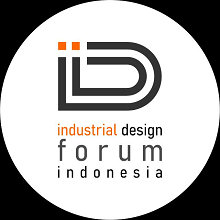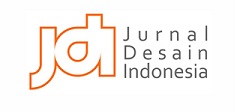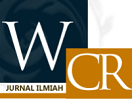PEMANFAATAN AMPAS KOPI SEBAGAI MATERIAL DASAR UNTUK MEMBUAT POT TANAMAN
Abstract
As the culture of drinking coffee strengthens in various circles of Indonesian society, the amount of residual dregs produced from brewing coffee drinks is also increasing. The main objective of this design process is to find the right mixture composition to reprocess coffee grounds so that they can be used as a basic material for making ornamental plant pots. In finding the right dough composition, this design was carried out through a material exploration approach by mixing several other binders with coffee grounds. After going through 30 trials involving several ingredients such as coffee grounds, starch, vinegar, glycerol, water, jelly, and PVA (Polyvinyl Alcohol), this experiment succeeded in getting the right and ideal composition with characteristics resembling clay and easy to use. molded and does not crack easily when dry. As a result, this design process succeeded in producing an initial product in the form of a small plant pot for ornamental plants made from the dregs left over from brewing coffee drinks. This ornamental plant pot product is an initial stage product which at the next design stage can be developed into a more complex and attractive product.
Keywords
Full Text:
PDF (Bahasa Indonesia)References
Andry & Sachari, A. (2015). Eksplorasi Material Berbasis Permainan Sebagai Pendekatan Berkreasi. Panggung, 25(3) p.292-304.
DOI:https://doi.org/10.26742/panggung.v25i3.25
Badan Pusat Statistik Indonesia. (2023). “Statistik Kopi Indonesia 2022” dalam Badan Pusat Statistik Indonesia, 30 November 2023. Diambil dari https://www.bps.go.id/id/publication/2023/11/30/abde293e6c0fc5d45aaa9fe8/statistik-kopi-indonesia-2022.html
Brown, M. E. (2016). Introduction to thermal analysis: Techniques and applications (2nd ed.). Springer International Publishing.
Callister, W. D., & Rethwisch, D. G. (2017). Materials science and engineering: An introduction (10th ed.). John Wiley & Sons.
Choi, S. E., Kim, K. H., Cho, Y. K., & Yoon, Y. (2019). Utilization of coffee ground waste as a source of adsorbent: Its adsorption behavior on heavy metals in aqueous solution. Journal of Cleaner Production, 228, 1363–1372.
Figueiredo, T. R., Rocha, M. V. P., Sousa, L. C., & Braga, R. M. (2021). Coffee dregs as a source of bio-based materials: A review. Journal of Cleaner Production, 311.
Hollas, J. M. (2004). Modern spectroscopy. John Wiley & Sons.
Karim, M. R., Mahmood, H., Ahmaruzzaman, M., & Islam, M. A. (2019). Biochar production from coffee waste: A comprehensive review. Journal of Cleaner Production, 232, 131–144.
Lee, S. M., Kim, S. H., Kim, N. J., & Lee, C. S. (2014). Effect of carbon fiber content on the mechanical properties and microstructure of Mg-Al-SiC composites fabricated by stir casting. Journal of Alloys and Compounds. 613, 253–258.
DOI:https://doi.org/10.1016/j.jallcom.2014.05.174
Maulana, M., Anggaraini, D., Yofinaldi, S., & Wirayuda, R. (2023). Pemanfaatan Limbah Ampas Kopi menjadi Pupuk Organik. Jurnal Sains Teknologi Dalam Pemberdayaan Masyarakat, 4(1), 9–14.
DOI:https://doi.org/10.31599/jstpm.v4i1.1631
Nurhayati, E., Hadiyanto, H., Pratama, A. B., & Widodo, S. (2020). Pemanfaatan Ampas Kopi Sebagai Bahan Baku Pembuatan Bioetanol.. Jurnal Kimia Sains Dan Aplikasi, 23(3), 80–87.
Prabawati, S. Y., Widiakongko, P. D., & Taqwim, M. A. (2023). Activated Charcoal from Coffee Dregs Waste as an Alternative Biosorbent of Cu(II) and Ag(I). Indonesian Journal of Chemistry, 23(4), 1120–1128.
DOI:https://doi.org/10.22146/ijc.83269
Reimer, L., & Kohl, H. (2008). Transmission electron microscopy: Physics of image formation and microanalysis (5th ed.). Springer Science & Business Media.
Rochmah, H. F., Kresnanda, A. S., & Asyidiq, M. L. (2021). Pemanfaatan Limbah Ampas Kopi Sebagai Upaya Pemberdayaan Petani Kopi di CV Frinsa Agrolestari, Bandung, Jawa Barat. Jurnal Sains Terapan : Wahana Informasi Dan Alih Teknologi Pertanian, 11(2), 60–69.
DOI:https://doi.org/10.29244/jstsv.11.2.60-69
S. Amr, M., El-Baz, & S. El-Henawy. (2013). Coffee waste as a potential source for the production of soaps. Journal of Cleaner Production, 47, 109–114.
Skoog, D. A., West, D. M., Holler, F. J., & Crouch, S. R. (2014). Fundamentals of analytical chemistry (9th ed.). Cengage Learning.
Tawfik, A., El-Zawawy, W. K., Khalil, A. A., & Youssef, A. M. (2015). Utilization of coffee dregs for production of highly porous ceramics with tailored microstructure. Journal of Materials Science, 50(2), 980–994.
DOI: http://dx.doi.org/10.22441/narada.2023/v10.i3.003
Refbacks
- There are currently no refbacks.
Fakultas Desain dan Seni Kreatif
Universitas Mercu Buana
Gedung E Lantai 4
Jl. Raya Meruya Selatan no.1, Kembangan, Jakarta 11650
Tlp./Fax: +62215871335
Journal International Standard Serial Number (ISSN) Registration:
The Journal is indexed by:
Tools for Citations & Plagiarism Detection:

Ciptaan disebarluaskan di bawah Lisensi Creative Commons Atribusi-NonKomersial 4.0 Internasional
 NARADA: Jurnal Desain dan Seni
NARADA: Jurnal Desain dan Seni

























